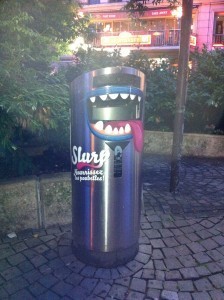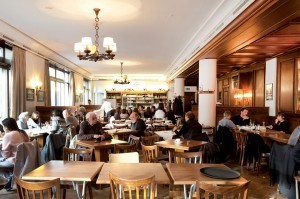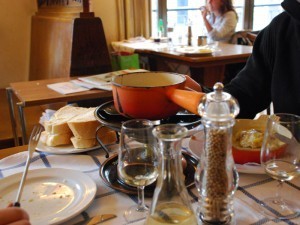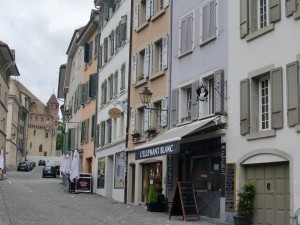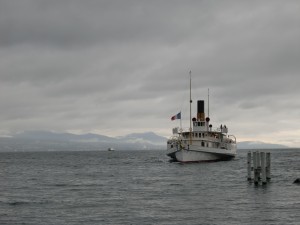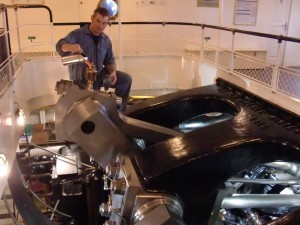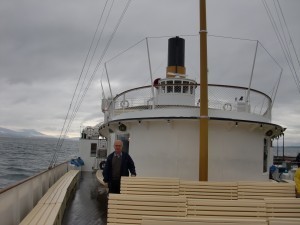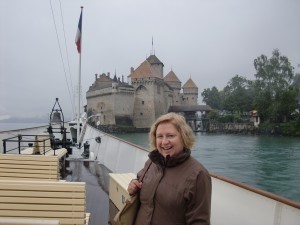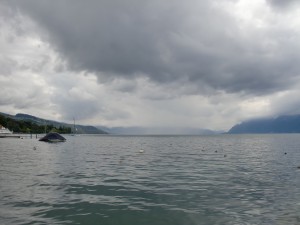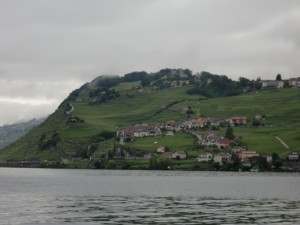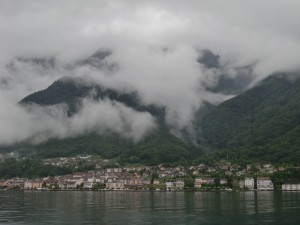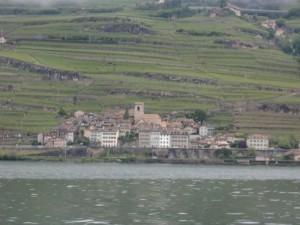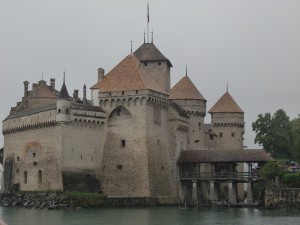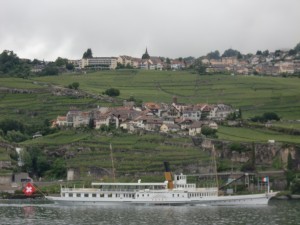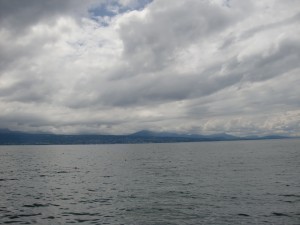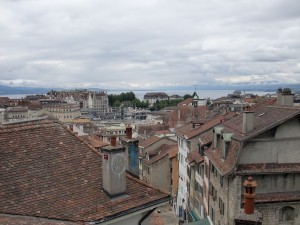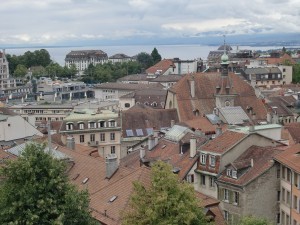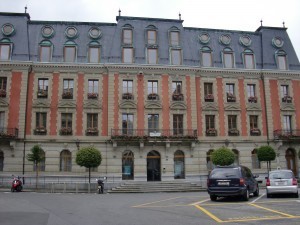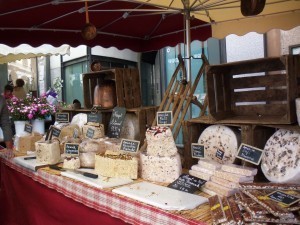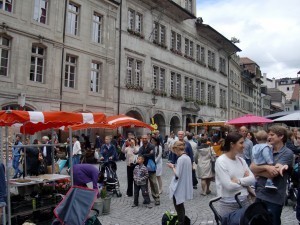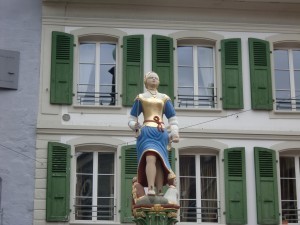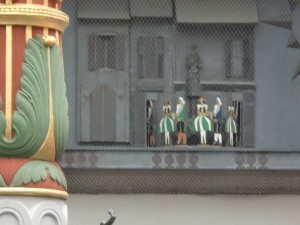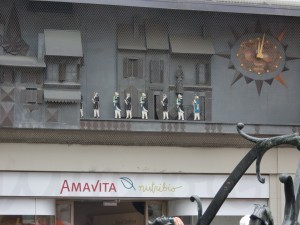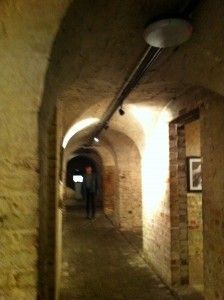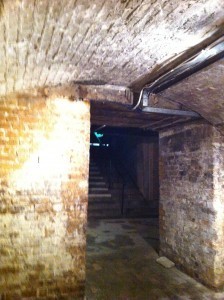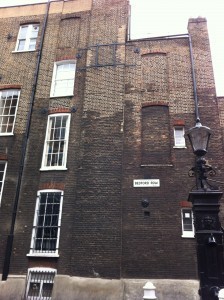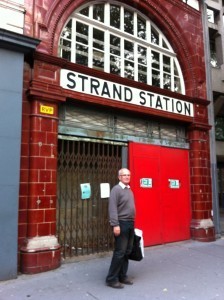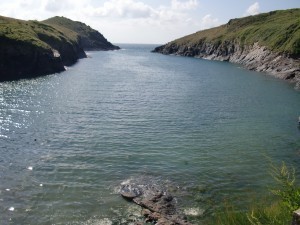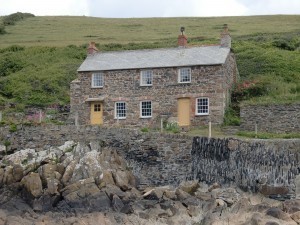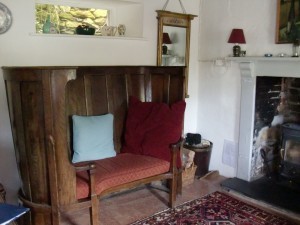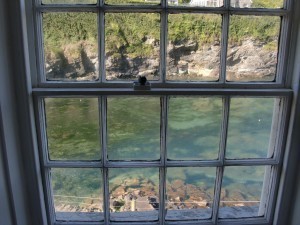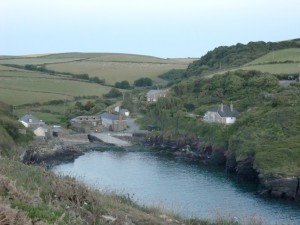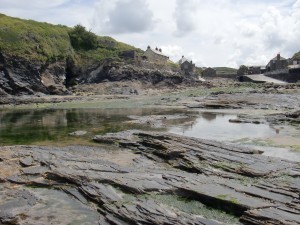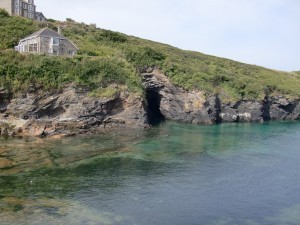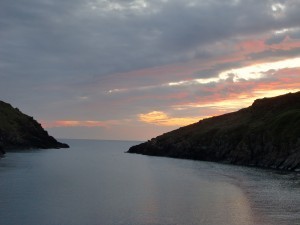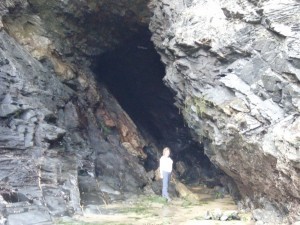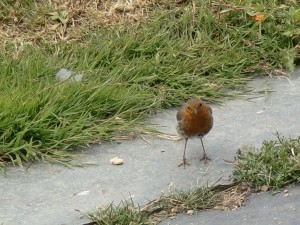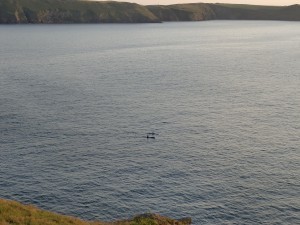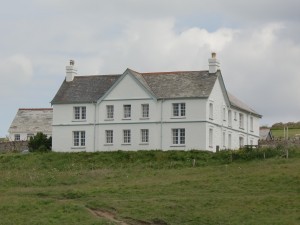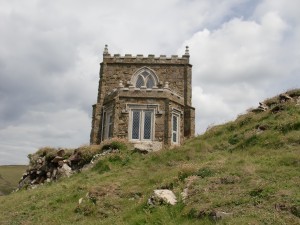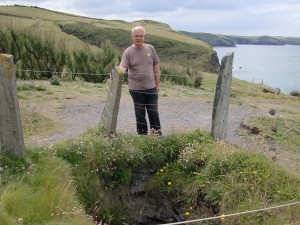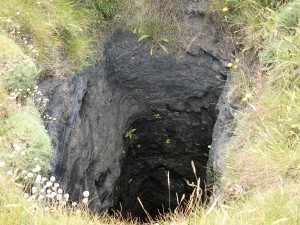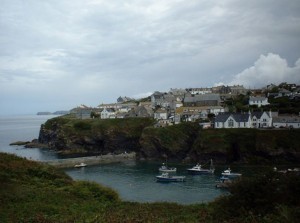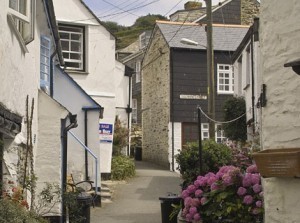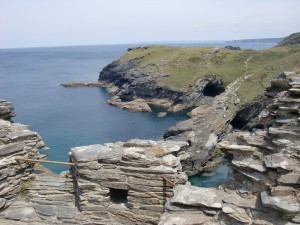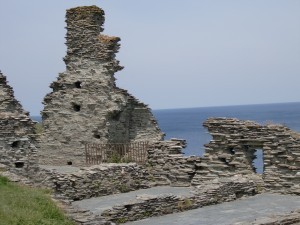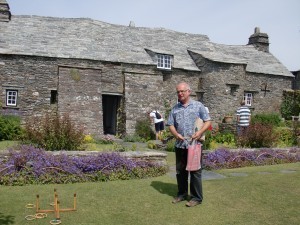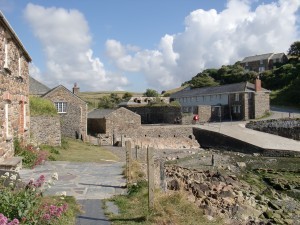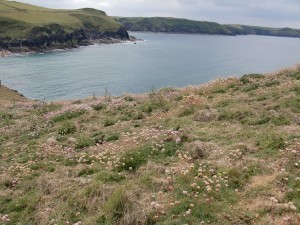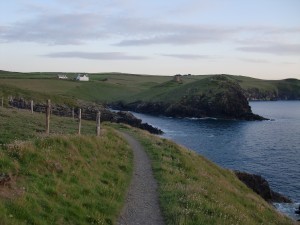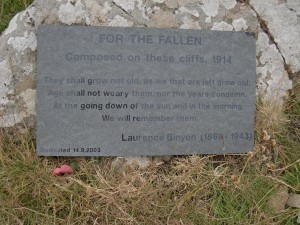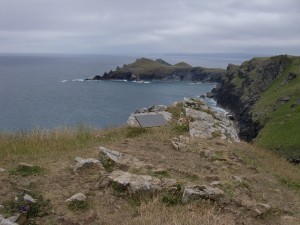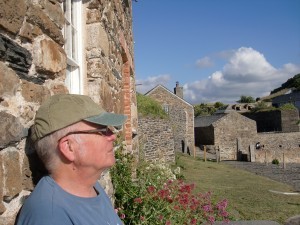Deborah Burrows's Blog, page 4
July 13, 2014
In Switzerland
We spent the week in Lausanne, Switzerland. Toby was attending and speaking at a digital humanities conference and I was ‘accompanying person’. Sadly for me, it was cold and wet all week. That should have meant I could spend time researching and writing, but I didn’t do much of that. Instead I got a good dose of writer’s block and read trashy novels instead.
The Swiss have a zany sense of humour. This is what the rubbish bins in Lausanne look like:
Tuesday night I had room service in Toby’s absence, but on Wednesday night Toby and I went our for dinner to the very busy Cafe Romand, which dates from 1951 and is rather a Lausanne legend for its fondue and traditional dishes. We decided to pass on the suggested local delicacies of cervelle au beurre noir (brains in black butter), tripe, pied de porc (pork trotters) and had – of course! – fondue. I don’t think I’ve had fondue since the 70s. Those of us who are old enough will recall that everyone seemed to get a fondue set for a wedding present or a 21st present in the late 70s.
The fondue served at the Romand was very, er, cheesy, but make no mistake, it was very tasty. I told Toby that the secret is to also order something sharp to cut through all the cheesy gloopiness, so we ordered sides of pickles and boiled potatoes and had a really enjoyable meal. This is a photo from the web; the restaurant was absolutely packed when we went:
On Thursday night we met up with some of Toby’s colleagues, to celebrate the amazing Deb Verhoeven’s 50th birthday. We went to a really excellent restaurant, the Elephant Blanc, in the old part of town behind the Cathedral. We had the top floor all to ourselves (the table of Americans near us just up and left for no discernible reason) and my meal – sole with risotto – was excellent.
On Friday morning Toby and I were determined to take a cruise along the eastern side of Lake Geneva. We dodged rain showers as we went on deck to see the views from our beautiful ship, La Suisse, the flagship of the Belle Epoch fleet:
It is one of eight steam powered ships built between 1904 and 1927 by Sulzer Brothers in Winterthur. They’ve been beautifully restored. The engine is remarkable:
Here we both are, proving that we took the voyage:
Lake Geneva is really lovely, although it was a shame about the weather.
Nevertheless, we saw some pretty little villages on the lakeside, and terraces of vines:
And even a medieval castle:
This is the sister ship of La Suisse, on her journey:
France lies directly across from Lausanne, specifically, the town of Evian.
On Saturday morning we managed to climb the myriad stairs and hills of Lausanne to have a walk around the old centre of the town. It was a pleasant (if mainly uphill) walk.
Is this the prettiest Police Headquarters in the world?
A weekly market had been set up in the streets and it was jolly to wander past little stalls with flowers, and spices and vegetables. And cheese! Amazing cheeses, Gruyere straight from Gruyere which is a couple of miles away; all sorts of cheese. The scent of them was heady.
Where’s Toby?
In the main square is a pretty statue of Victory:
And of course, it being Switzerland, there is a clock behind her, a type of cuckoo clock, with figures that wind around to a sweet little tune.
Switzerland comes in for a lot of ribbing about its cuckoo clocks, all because of the movie The Third Man, in which Orson Wells states:
“In Italy, for thirty years under the Borgias, they had warfare, terror, murder and bloodshed, but they produced Michelangelo, Leonardo da Vinci and the Renaissance. In Switzerland, they had brotherly love, they had five hundred years of democracy and peace – and what did that produce? The cuckoo clock.”
/The Third Man (1949), by Carol Reed/
But maybe it’s just jealousy for the peace, order and prosperity, which over the years Switzerland has established using a direct democracy.
I did manage to do some research, as I’d taken with me my new book: “Forgotten Voices of the Blitz and the Battle for Britain”, which was written in association with the Imperial War Museum. It sets out quotes from those who lived through it all, not only the British pilots and civilians, but also German pilots who flew on the raids. I found it incredibly moving and interesting. I had to force back tears on the Swiss Air flight home yesterday, as I was reading about the human cost of the battles and the bombings.
This in particular I found amazing. Robert Grant-Ferris, a British MP and fighter pilot, was asked to move the loyal address at the opening of Parliament six weeks after the end of the Battle of Britain in 1941. The writer and diplomat Harold Nicolson (also the husband of Vita Sackville-West) had the perfect peroration (ending) to his speech, but was was unable to get it to Grant-Ferris in time for him to include it.
It is a poem, written in 1737 by Thomas Gray, who is well known for his “Elegy Written in a Country Churchyard”.
The day will come when thou shalt lift thine eyes
To watch a long drawn battle of the skies
And aged peasants too amazed for words,
Stare at the flying fleets of wondrous birds.
And England, so long mistress of the seas
Where winds and waves confess her sovereignty
Her ancient triumphs yet on high shall bear
And reign the sovereign of the conquered air.
Amazingly prescient, given that it was written 200 years before the Battle of Britain, and way before humans took to the skies.
I’ve been reading novels written during the Second World War, to get a feel for the language and the sensibilities of the time. As I’ve said before, it is amazingly easy to get hold of any book you want here and I’d better be careful or I’ll use up all of my savings in books!
And yet . . . one of the reasons I write historical fiction is because I enjoy the research so much: wandering through London working out what areas were bombed, cooking meals from a book called “The Ration Book Diet” to eat what my characters might have eaten, crying (or rather trying not to cry) over the personal accounts of bravery and horror, checking dry war histories to ensure that my dates and accounts of battles and bombings are correct, enjoying the exquisite phrasing of novelists such as Elizabeth Howard, Duff Cooper, Marghanita Laski or Patrick Hamilton as they describe their very real, very flawed characters, who lived in such a different England to the one I live in now.
We’re back in Oxford at present and we’re going to stay here for a while! I need to write and research and Toby is also going to be very busy. I’m happy to be home and very grateful that I’m able to call such a lovely place home.
July 6, 2014
A holiday in Cornwall and The Blitz in Bloomsbury
Sorry if I’ve not replied to various emails, as we’ve been in Cornwall and out of internet and even telephone reach. Its been a hectic week and a half.
On Saturday 28 June (which is my darling mother’s birthday; she would have been 94 years old) we went into London. It was a grey day, with light drizzle, but I was on a Mission and didn’t let that worry me.
I’d bought a copy of “A Wander through Wartime London: Five Walks Revisiting the Blitz”, and I was determined to do the Bloomsbury walk. So Toby and I wandered around Bloomsbury in the drizzle, revisiting the Blitz.
I feel very comfortable writing about the area now, because I’ve now walked the streets where my heroine drove her ambulance and I’ve seen the site of her Auxiliary Ambulance Station 56A in Woburn Place. It was in the garages in the basement of this huge apartment block:
It was a fascinating awalk, which included various sites where bombs fell, in both world wars. Did you know that Bloomsbury was pounded by the Zeppelins and Gotha bombers in the First World War, as well as by the bombs of the Second World War? And, sadly, it was hit again in 2005, when the 7/7 bombings occurred.
We went into the crypt of St Pancras Church, which was used as an air raid shelter. I wondered what it must have been like to come here, night after night, and wait for the All Clear as the walls shook with each bomb that hit nearby.
It’s fairly easy to spot where there was a direct hit in the Blitz; a street will be a picture of Victorian elegance and then a jarring note appears – a new building completely out of character in the street in the middle of a row of eighteenth or nineteenth century houses.
You can see in this picture that the top floor of the building was destroyed and rebuilt in differently coloured bricks.
After our walk around Bloomsbury we made our way to Aldwych Tube Station, which was at first known as the Strand, which was closed down in the 1990s. It is available for a week each year for guided tours of the old station. It opened in 1904 and still has many features of that gracious time. It was also used as an air raid shelter in WW2, and nowadays is often leased to film and television companies who want to shoot scenes set in the underground. It was a fascinating tour.
On Sunday we headed off to North Cornwall. Our lovely neighbour, Venetia, offered us the use of her family’s 200 year old fishing cottage, which is located at the head of Port Quin, a really beautiful little bay, next to Port Isaac, which is the setting for the Doc Martin TV series.
It’s a long journey to Cornwall, even on the motorways, but we got there at around 5.00 to see this:
Quay cottage is at the very end of the quay.
It is filled with antiques and has a view of the water from every window:
Port Quin is a tiny village with less than a dozen stone houses, now almost all owned by the National Trust. This is a view of the village from the headland, with Quay Cottage on the left.
It was amazingly restful, just to watch the tide come in and out, which it did in rather spectacular fashion twice a day. At low tide the bay looked like this:
As opposed to high tide, when it looked like this:
The sunsets really were spectacular:
We went exploring at low tide into the sea cave we could see from our windows, where kayakers had paddled just hours before.
We made friends with a robin. One morning he got a bit too friendly and came inside the cottage. I had to act quickly to wrap him in a calico bag and get him outside. He seemed no worse for wear, though.
The seas were millpond calm the whole time we were there and it rained only on the day we left. Here are a couple of sea kayakers. They’d set up and depart from our bay, then paddle out past the headland, on a sea as gentle as I could ever imagine.
And we certainly got our exercise by walking along the coastal path both ways. The scenery really was spectacular and the photos don’t do it justice. One day we walked up a hill and over a field and came to Doyden House, where Venetia grew up.
Venetia’s family used to own most of the land, the fishing cottages, the farm, Doyden House and Doyden Castle, which is an early 19th Century folly that looks like a tiny castle set right out on the headland. Her parents left it all to the National Trust, with the exception of Quay Cottage, which the family kept for themselves. The National Trust now rents out the cottages, the house and the castle and looks after the area.
This is Doyden Castle. If you’re a Doc Martin fan, it’s where the baby was dangled out of the window. We were told this interesting fact by a couple of passing walkers as we gazed at it. The National Trust rents it out as a posh holiday cottage, and to TV and movie producers.
And here are the House and Castle together.
These are old abandoned mine workings. I dropped in a few rocks but couldn’t hear them hit the ground.
On Monday we met our friends Sally and Ian Vanderfeen, who were serendipitously in Cornwall visiting relatives as part of their 3 month grand European holiday. We had tea with them in Port Isaac, a very pretty little village but oh, so touristy due to Doc Martin.
On Wednesday we drove out to Tintagel, a spectacular part of the coast and the next bay along from Port Isaac. Again very touristy and, very hot!! Too hot to scramble over rocks.
So we had a look at a medieval house in the village:
and went on to Boscastle, a pretty harbourside village a little further along the coast.
On our last evening – and the light lasts until 10.00pm so the evenings are long and lovely – we went for a last walk along the coastal path towards the town of Polzeath via Pentire Point and the Rumps. It’s a wonderfully craggy coastline.
And on Pentire Point we found the plaque commemorating the spot where Laurence Binyon composed ‘For the Fallen’ in 1914. This is the poem which contains what is now known as the ‘Ode of Remembrance’:
They shall grow not old, as we that are left grow old
Age shall not weary them, nor the years condemn.
At the going down of the sun and in the morning
We will remember them.
Binyon said, in 1939, “I can’t recall the exact date beyond that it was shortly after the retreat [from Mons]. I was set down, out of doors, on a cliff in Polzeath, Cornwall. The stanza ‘They shall not grow old’ was written first and dictated the rhythmical movement of the whole poem.”
It’s a lovely spot to write such lovely words, which always make me cry.
I managed to get in some writing myself and am now up to 8,500 words. I’m never really happy until I’m at 10,000, which is 10% of the finished novel. It’s easy to write when the only sounds are the haunting cries of the English gulls and the gentle waves lapping below the cottage.
Here is Toby, relaxing in the sun:
Then we drove back to Oxford. Tomorrow (Monday) we fly to Lausanne, on the shores of Lake Geneva in Switzerland. Toby is to deliver a paper at a conference there and we’re away for the week.
Love to all
Deb
May 23, 2012
1940s make-up
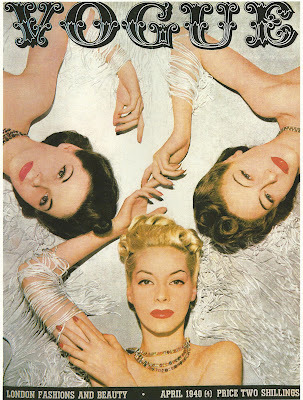
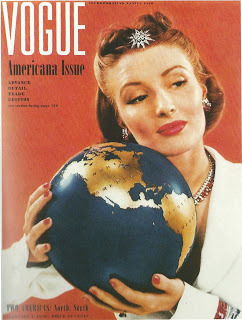
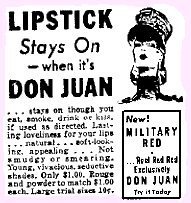 Movie stars influenced the makeup of the 1940s. Joan Crawford’s lipstick shape “the smear” or Hunter’s Bow, created by Max Factor in the late ‘30s, was much copied. Going to the pictures was a popular way to spend an evening and the glamour of the movie stars was admired and copied by women everywhere...
Movie stars influenced the makeup of the 1940s. Joan Crawford’s lipstick shape “the smear” or Hunter’s Bow, created by Max Factor in the late ‘30s, was much copied. Going to the pictures was a popular way to spend an evening and the glamour of the movie stars was admired and copied by women everywhere...
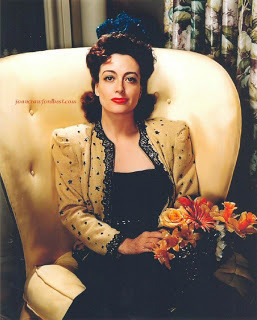
The overall makeup look of the 1940s was natural, from pale to slightly tanned skin tones, penciled in brows, a lashing of mascara and a rosy glow to the cheeks, topped off with a splash of red lipstick glamour. The fashionable forties lip shape was deep, rounded and full. Lucious lips!

May 8, 2012
1940s pageboy hairstyle
Hairstyles in the 1940s were fuller and longer than those of the 1930s. The side part was a signature of the 1940s, as it was the foundation for most styles.
The pageboy hairdo was stylish among young women.
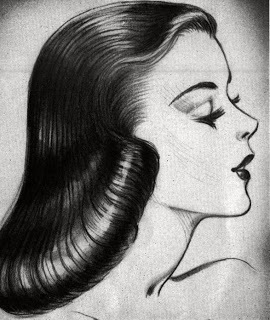

The 1940s pageboy hairstyle had a lot more volume than the sleeker version that was prevalent in the 1950s and 60s. Women set their curls by wetting and pin-curling the hair, then letting it dry for hours, sometimes overnight. The hair was then vigorously brushed and curled under.
This is a you-tube tutorial on how to achieve an authentic 1940s pageboy 'do'.
April 29, 2012
Nurses World War 2 - Australia
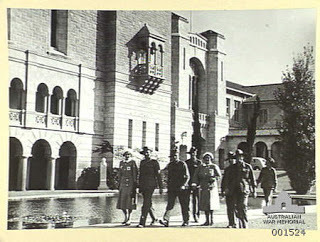 This is at my very own University of Western Australia, in 1940. Nurses and soldiers looking around prior to embarkation for the Middle East.
This is at my very own University of Western Australia, in 1940. Nurses and soldiers looking around prior to embarkation for the Middle East.  On the ship the quarters weren't that bad!
On the ship the quarters weren't that bad!
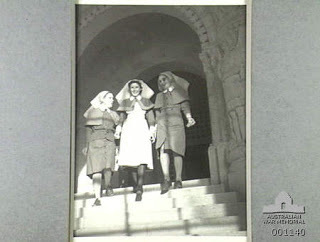 Australian and UK nurses in Palestine 1941.
Australian and UK nurses in Palestine 1941.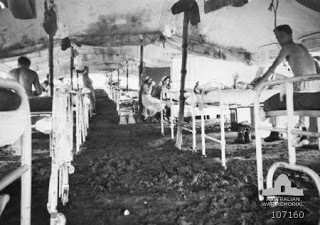 The girls had to enjoy themselves in Jerusalem, because field hospitals like this awaited them. Note the dirt floors.
The girls had to enjoy themselves in Jerusalem, because field hospitals like this awaited them. Note the dirt floors.Then the war came to Australia. The troops were recalled and we were fighting the Japanese.
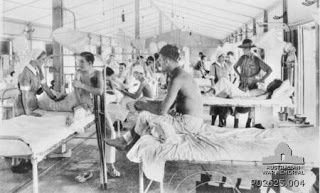 In Darwin after the first air raid, February 1942.
In Darwin after the first air raid, February 1942.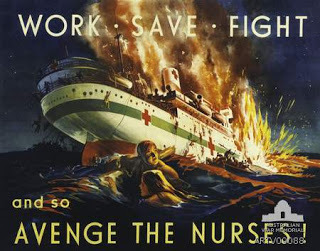 This poster depicts the Hospital ship, 'Centaur' being attacked by the Japanese off the coast of Queensland. In the water below the ship are a number of nurses and sailors from the ship. The sinking of H S Centaur took place off the Queensland coast on 14 May 1943 and 268 lives were lost, including 11 out of 12 nurses. The poster depicts moments after the ship was torpedoed; it sank in just three minutes.
This poster depicts the Hospital ship, 'Centaur' being attacked by the Japanese off the coast of Queensland. In the water below the ship are a number of nurses and sailors from the ship. The sinking of H S Centaur took place off the Queensland coast on 14 May 1943 and 268 lives were lost, including 11 out of 12 nurses. The poster depicts moments after the ship was torpedoed; it sank in just three minutes.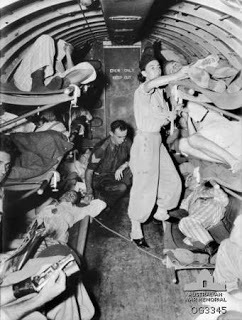 An RAAF nurse, tending to the wounded during an evacuation flight.
An RAAF nurse, tending to the wounded during an evacuation flight.
 Even in New Guinea in 1943 a nurse has to look her best.
Even in New Guinea in 1943 a nurse has to look her best.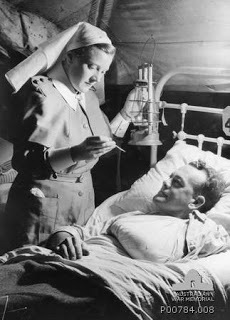 In a Queensland hospital 1944.
In a Queensland hospital 1944.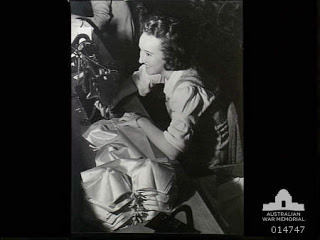 It's 1943 and this Aussie girl is making corsets for American nurses stationed in the South Pacific - the girls needed all the support they could get! Imagine wearing a corset on a tropical island!
It's 1943 and this Aussie girl is making corsets for American nurses stationed in the South Pacific - the girls needed all the support they could get! Imagine wearing a corset on a tropical island!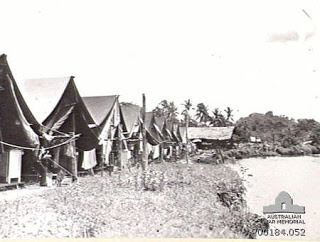 New Guinea 1943 - a tent ward.
New Guinea 1943 - a tent ward. 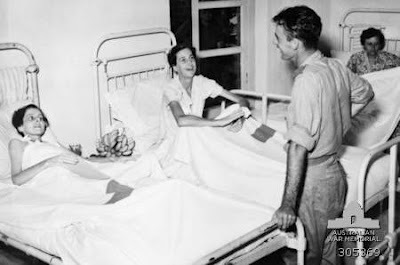 It's 1945. These Australian nurses had spent three and a half years as prisoners of the Japanese in Sumatra and were recuperating from malnutrition. And yet, were still able to flirt with a handsome Aussie soldier! Go girls.
It's 1945. These Australian nurses had spent three and a half years as prisoners of the Japanese in Sumatra and were recuperating from malnutrition. And yet, were still able to flirt with a handsome Aussie soldier! Go girls.By the end of the war, nursing sisters had been commissioned as officers, althought they did not have the same status or pay as the male officers.
April 16, 2012
Rationing in World War 2 Australia
My book, A Stranger in My Street, is officially out in June, but there will be copies in the bookstores in mid-May! Apparently the orders from the bookshops have been healthy, so the print run is reasonable.
My agent, Sheila Drummond, is currently at the London Book Fair, trying to sell publishing rights in England, Europe and the US.
I'm having a photo shoot on the weekend for the newspaper articles that my publicist, Jace, has set up. I bought a new outfit for it on Saturday. I'm booked to talk at a library and at an Arts Centre. I'll be what is charmingly called, a 'media-whore'.
It's slightly daunting, but, hey - life is change and challenges. So it's also exciting...
I thought I'd talk about rationing in Australia in World War 2. For the first time, Australia actually felt threatened, and it went into War Mode very quickly. People really pulled together because of the perceived threat from Japan.
Chocolate was available only if you knew an American, because:
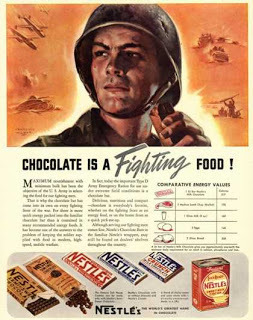
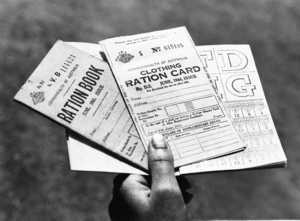
Rationing regulations for food and clothing were gazetted on 14 May 1942 and the idea was to curb inflation, reduce total consumer spending, and limit potential shortages of essential goods by ensuring an equitable distribution of food and clothing. But Australians were never as short of food nor rationed as heavily as civilians in the United Kingdom. Rationing was limited to clothing, tea, sugar, butter, and meat, but from time to time, eggs and milk were also rationed under a system of priority, so that it only went to those who really needed it during periods of shortage. You were allocated coupons, which had to be traded for the rationed item.
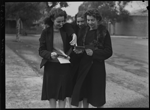
It was actually rather healthy, the lack of excess that came with rationing. In Australia, the weekly food ration was:

Meat900gButter225gSugar450gTea90g
On beef-less days it was an offence to buy, sell or eat beef. The 'Australian Women’s Weekly' ran a competition for the best meatless recipe. The winning recipe was for mock sausages:
'Boil one cup rolled oats in three-quarters cup salted water for 15 mins, then add finely chopped onion to flavour. Mix well, empty into basin. When cool add one beaten egg, pepper and herbs to taste, one cup breadcrumbs. Shape into sausages, roll in flour and fry in deep boiling fat until golden brown.'
What is really interesting is how long rationing went on for after the war ended:
ItemDate gazettedDate abolishedQuantity per adultClothing12 June 194224 June 1948112 coupons per yearTea6 July 1942July 1950lb per 5 weeksSugar29 August 19423 July 19472 lb per fortnightButter7 June 1943June 19501 lb per fortnightMeat14 January 194424 June 19482 lbs per week
Ending rationing was one of the promises of the Menzies Liberal Party - and it won power by a landslide in 1949!
April 14, 2012
Over-sexed, overpaid and over here!
 The first Americans arrived in Brisbane on 22 December 1941. By mid 1943 there were were 150,000 in Australia, with the largest concentrations in Queensland (near Brisbane, Rockhampton, and Townsville). But US naval forces were also frequently anchored at Sydney and Perth. General Douglas MacArthur, who was appointed as the Supreme Commander of South-West Pacific Area on 18 April 1942, was based in Melbourne before he moved to Brisbane.
The first Americans arrived in Brisbane on 22 December 1941. By mid 1943 there were were 150,000 in Australia, with the largest concentrations in Queensland (near Brisbane, Rockhampton, and Townsville). But US naval forces were also frequently anchored at Sydney and Perth. General Douglas MacArthur, who was appointed as the Supreme Commander of South-West Pacific Area on 18 April 1942, was based in Melbourne before he moved to Brisbane. 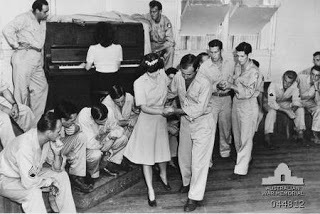 Almost one million American service personnel passed through Australia during World War 2. Cafés began advertising Coca-Cola, coffee, and hamburgers. Hot-dog stands appeared. By the end of 1944, two-thirds of Australia’s imports came from the United States.
Almost one million American service personnel passed through Australia during World War 2. Cafés began advertising Coca-Cola, coffee, and hamburgers. Hot-dog stands appeared. By the end of 1944, two-thirds of Australia’s imports came from the United States.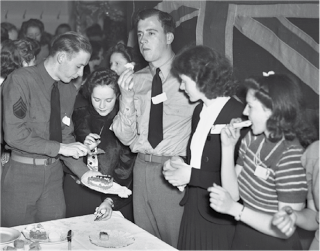 The Diggers were a poor bet when it came to showing a girl a good time, because the Yanks did earn a lot more money. American soldiers in the lower ranks earned twice the amount of their Australian counterparts - a US private earned the same as an Australian captain. In the higher ranks the disparity was even more pronounced. These differences in pay scales, their stylish uniforms (with zippered flies!), and their custom of tipping earned the Americans a reputation as "big spenders".
The Diggers were a poor bet when it came to showing a girl a good time, because the Yanks did earn a lot more money. American soldiers in the lower ranks earned twice the amount of their Australian counterparts - a US private earned the same as an Australian captain. In the higher ranks the disparity was even more pronounced. These differences in pay scales, their stylish uniforms (with zippered flies!), and their custom of tipping earned the Americans a reputation as "big spenders". 
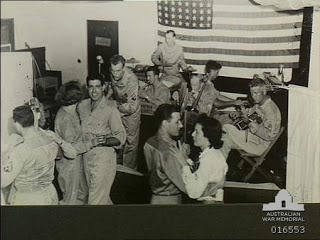 There were major disagreements between Australian and American forces over rates of pay, food rations, women, race relations, and fighting skill. In November 1942 was the infamous "Battle of Brisbane" but similar skirmishes occurred in all the cities where Americans were based.
There were major disagreements between Australian and American forces over rates of pay, food rations, women, race relations, and fighting skill. In November 1942 was the infamous "Battle of Brisbane" but similar skirmishes occurred in all the cities where Americans were based.
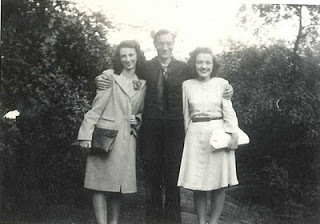
Many Australian women saw the well-paid Americans as desirable and romantic. More than 12,000 Australian women became American war brides, most of whom returned to the US with their new husbands at the end of the war.
April 10, 2012
Women's work - how we helped to win the war
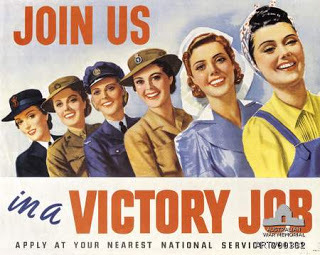 With the war came the need for women to join the war effort.
With the war came the need for women to join the war effort.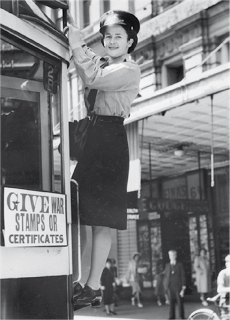
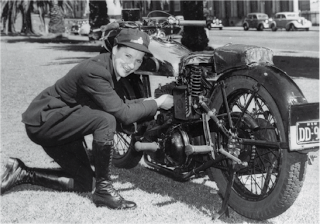
For the first time in Australia women were being asked to do 'a man's job', either in the services or in industry. More women entered the workforce than had been there before, and many took on jobs that had previously been available to men only, earning all or nearly all the male rate for these 'men's jobs'.
If the new women workers went into traditionally female areas, then the wage was typically 54 per cent of the male rate - though by the end of the war was closer to 70 per cent.
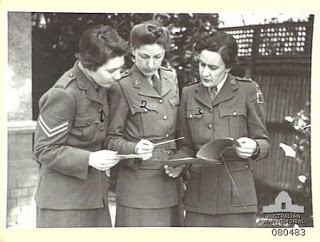 Women who entered the services were also paid at a far lower rate than their male counterparts doing exactly the same job, and these jobs disappeared at the end of the war.
Women who entered the services were also paid at a far lower rate than their male counterparts doing exactly the same job, and these jobs disappeared at the end of the war. 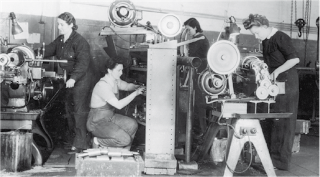
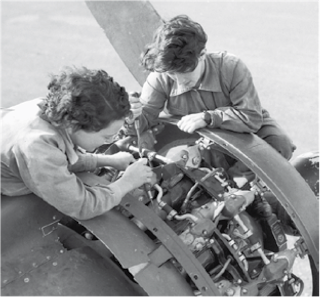
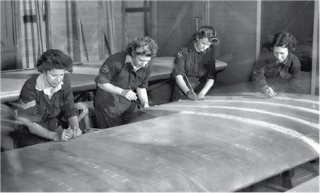
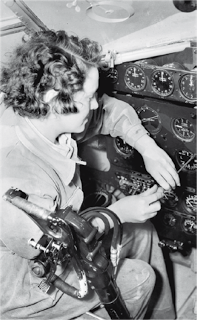
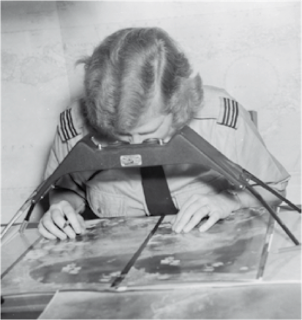
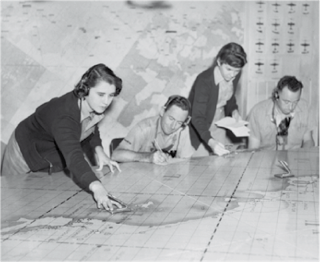
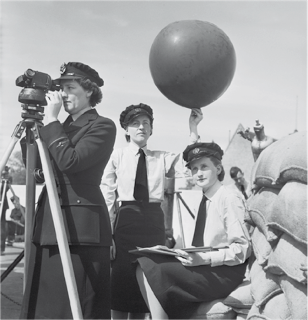
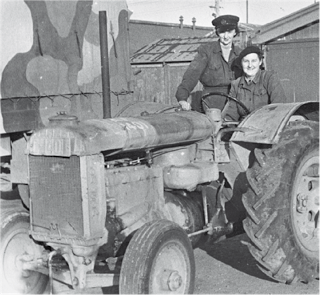
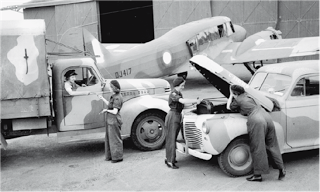
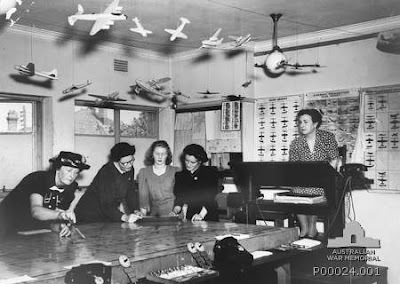
The experience of work in the war years had a profoundlyliberating effect on many women. Many felt it was the happiest time of their lives.And many sought jobs after the war that would continue this independence andliberation. But society dictated that a woman's place was best in the home, andmost were happy to return to normal domestic life.This post is for the unsung heroines – doing so-called men'swork and doing it brilliantly!
March 28, 2012
Dancing with Americans in wartime Australia
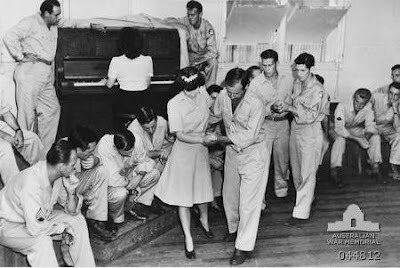 The girls are learning how to jitterbug - that crazy American dance!!
The girls are learning how to jitterbug - that crazy American dance!!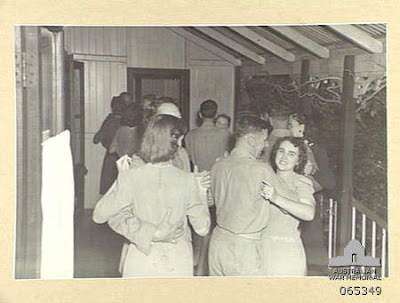 People danced anywhere - even on a verandah.
People danced anywhere - even on a verandah.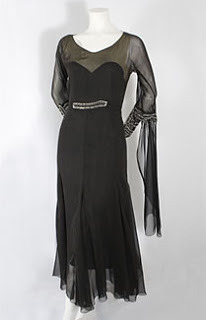 This is a chic dance frock from the 1940s.
This is a chic dance frock from the 1940s.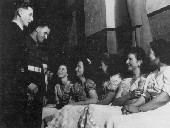 Care to 'cut a rug' ladies?
Care to 'cut a rug' ladies?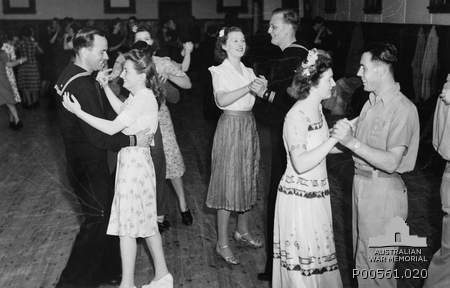 Dancing with Americans. I love the flowers in the hair of the girl with the fancy frock. Everyone is having a great time.
Dancing with Americans. I love the flowers in the hair of the girl with the fancy frock. Everyone is having a great time.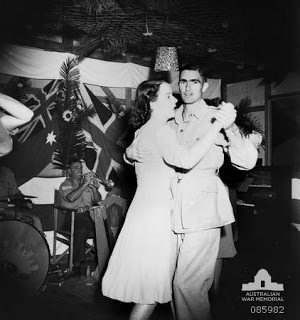 This fellow looks just as I imagine the hero of my novel, whose name is Tom Lagrange. Tall, dark and very handsome.
This fellow looks just as I imagine the hero of my novel, whose name is Tom Lagrange. Tall, dark and very handsome.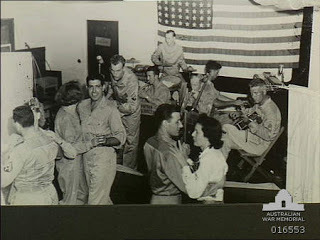 I love this photo. It's a dance for American servicemen in an Australian city, perhaps Melbourne. Everyone seems to be having a great time, and the band are rocking...
I love this photo. It's a dance for American servicemen in an Australian city, perhaps Melbourne. Everyone seems to be having a great time, and the band are rocking...March 14, 2012
Soldier's farewell
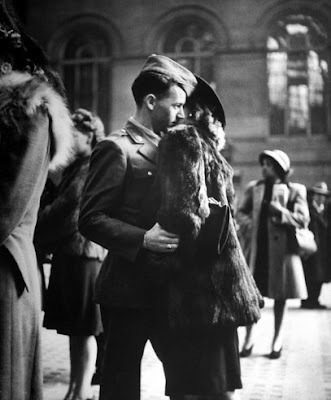
I put this photo on my facebook page, because I thought it was so cool, with the women's amazing outfits and the beautiful old railway station and the two bodies frozen in a moment of farewell.
My niece wrote that she loved the photo. And then she wrote that she couldn't look at it any more because he was so sad.
She's right, of course. There is an ocean of sadness in his eyes.
So many men looked just as miserable as they took farewell of the ones they loved. I hope this one made it home...

